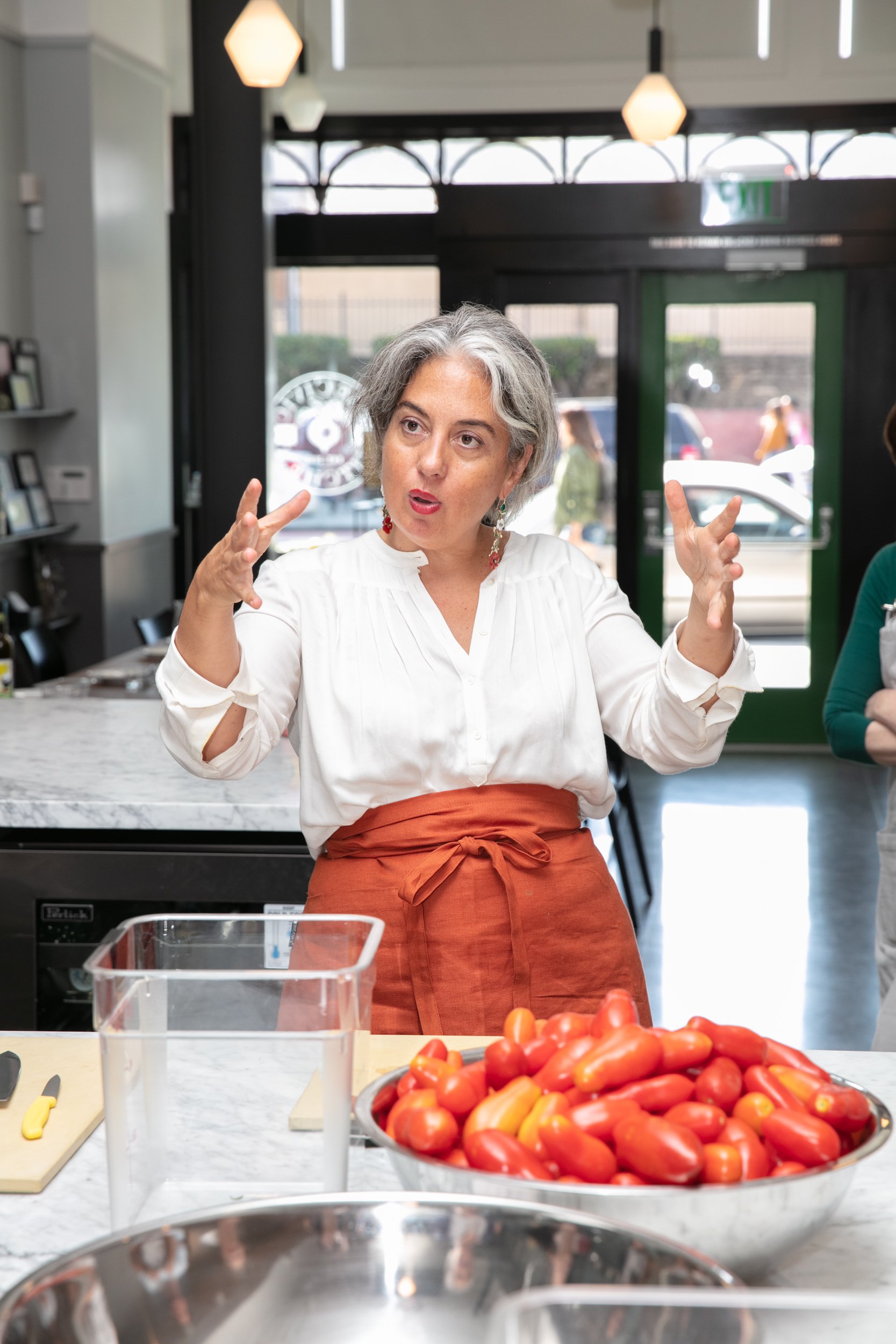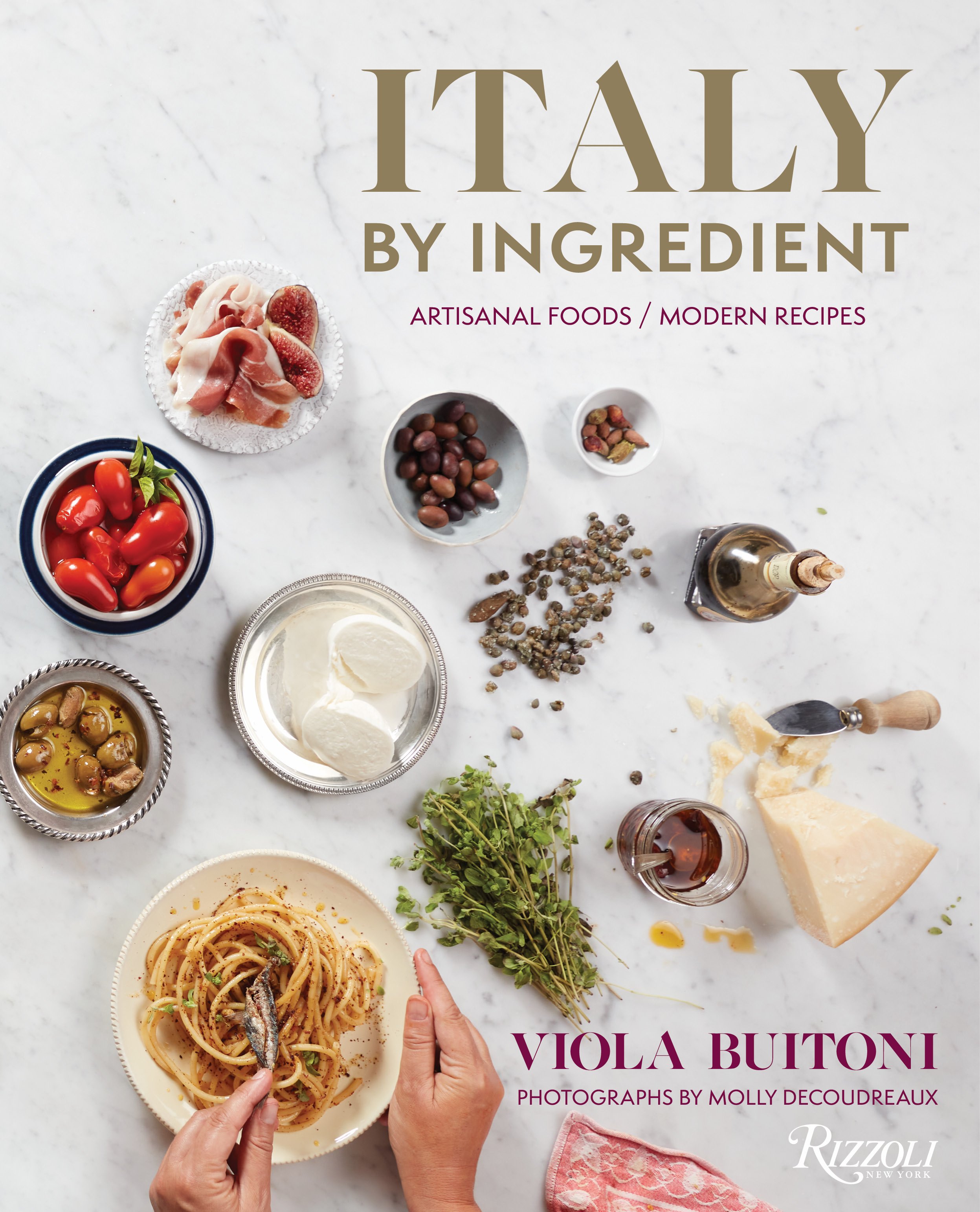Why Viola Buitoni’s Italy by Ingredient is a Celebration of Iconic Italian Cheeses
Viola Buitoni at Civic Kitchen
“I have been cooking my whole life,” says Viola Buitoni. “I come from a food family—Italy by Ingredient is a story of a lifestyle.” Born in Rome and raised in the Umbrian countryside, on a fifteenth-century former convent surrounded by an olive grove and grazing sheep that made pecorino, Buitoni was weaned on extra-virgin olive oil and Parmigiano Reggiano. She writes, “I first spooned ricotta into my mouth straight out of the warm whey in which the local shepherd had just cooked it.”
And yes, Viola Buitoni is a Buitoni, like the pasta. She’s the sixth generation of an Italian family who mechanized the production and distribution of pasta (Buitoni is now owned by Nestle).
When Buitoni left her hometown for New York University, everything changed. She studied economics, but she longed for her family food. During and after college, she worked in New York City’s Italian restaurants, both in the kitchen and in the front-of-the-house. “I got my chops,” she remembers. She realized it was food, not economics, that had won her heart. Buitoni opened her own catering business, where she served simple, elegant Italian food.
She dated her now husband, who then lived in San Francisco, long distance for five years before deciding to close her shop and move across the country. After having her son, she knew she didn’t want to return to the grueling hours of restaurant or catering work. So Buitoni started teaching cooking classes, which was a perfect fit.
Teaching people how to cook was “the condensation of my experience and work,” says Buitoni. “I was teaching people how to be in the kitchen, find yourself in the kitchen, and make cooking a joyful everyday art.” She knows most people don’t want to—or can’t—spend all day on a cooking project, so her recipes are mostly approachable, fast dishes that help people “come to the stove and around the table every day.”
Italian Cheeses
Italy By Ingredient cover
Her new book, Italy by Ingredient: Artisanal Foods, Modern Recipes, is the next best thing to taking a hands-on class with Buitoni. Her cooking philosophy is to engage her attention and senses during the process. “When you deal with food, you deal with a living, breathing thing,” Buitoni explains. If you look, taste, smell, and experience each ingredient and the alchemy they create, you are well on your way to becoming an excellent cook.
“Ingredients are the basis of most cooking,” Buitoni says. “If your recipe doesn’t have many ingredients, they have to be really good.” Her cookbook highlights five iconic Italian cheeses: Parmigiano Reggiano, Pecorino Romano, mozzarella, ricotta, and burrata. She presents a brief history and geography of these staple cheeses before showing her readers how to incorporate their robust flavors in their own kitchens.
“Millennia of craft and wisdom have shaped parmigiano and pecorino into flavors that amplify and ameliorate even the most humble dish,” writes Buitoni. Parmigiano Reggiano is so beloved that it is one of most Italian babies’ first foods.
Burrata is the newest cheese Buitoni includes in her book; she calls it “the sexiest cheese that ever lived.” Although it was a rare treat and not a staple when she was growing up, it has slowly but surely become ubiquitous and beloved. She uses it as a luxurious topping for orecchiette with roasted cherry tomatoes.
“Every place I have visited in the United States had an Italian deli, and, invariably, it was a trove of well-priced staples,” says Buitoni. “Wherever you are, find and befriend your Italian grocer.” She especially loves the Arthur Avenue covered market in the Bronx, Brooklyn’s Coluccio, and Market Hall in Berkeley, CA. Buon’Italia in the Chelsea Market in Manhattan and Di Palo’s in New York City’s Little Italy are also favorites.
At any of these spots, you can get a fresh ball of mozzarella to transform into this no-fuss, crowd-pleasing mozzarella and pepper tart. She uses premade puff pastry and sprinkles a bit of Parmigiano Reggiano on top for its salty, punchy bite. Like all her recipes, there are only a handful of ingredients. They all shine.
Sfogliata di mozzarella e peperoni
Sfogliata di mozzarella e peperoni photo by Molly Decoudreaux
Peppers and mozzarella flaky tart
For 8-10 people
1 pound / 450 g puff pastry
2 red bell peppers
1 orange or yellow bell pepper
1 ball (8 ounces / 225 g) fresh mozzarella
1 oregano sprig, or
1 teaspoon dried oregano
1 egg
Salt
2 tablespoons grated parmigiano reggiano
Pinch of pepper
If the puff pastry is frozen, thaw according to the package directions.
Heat the oven to 350 ̊F / 190°C / gas mark 4. Line a sheet pan with parchment paper and place the bell peppers on it. Slide into the oven. Roast for about 25 minutes, until the skin has burnt spots and the peppers have collapsed and wrinkled. Grab them with tongs, drop them into a brown paper bag, roll the top of the bag closed, and let sit for 10 minutes. This technique makes the peppers easy to peel. Leave the oven on.
Meanwhile, line a plate with a paper towel. Drain the mozzarella and chop it roughly, then place it on the paper towel to lose moisture. If using fresh oregano, strip the leaves off the sprig and finely chop them. Break the egg into a small bowl and lightly whisk it. Peel the peppers, cut them in half, and remove the core, filaments, and seeds. Pat them dry and slice into strips 1⁄4 inch / 6 mm wide along the ribbing.
Line the sheet pan with fresh parchment paper. Lay the puff pastry sheet on the parchment and prick it in 8 to 10 spots with a fork. Sprinkle the pastry with a pinch of salt and scatter the mozzarella over it, leaving a 11⁄2-inch / 4-cm clear border around the edges. Dust the mozzarella with the parmigiano and oregano, then season it with 1 teaspoon salt and the pepper.
Arrange the roasted pepper strips over the tart in whatever pattern you fancy, staying clear of the empty edges. On the day Molly and I shot the tart’s portrait, my fancy was an attempt at a corn stalk. Loosely roll the uncovered pastry edge onto itself until it borders the peppers.
Slide the tart into the oven and set a timer for 30 minutes. When the timer goes off, brush the edges of the tart with the beaten egg and slide it back into the oven. Set the timer for another 15 minutes. When the timer goes off, your tart is done. Let it rest and cool a little before eating.
Recipe from Italy by Ingredient published with permission of Rizzoli



